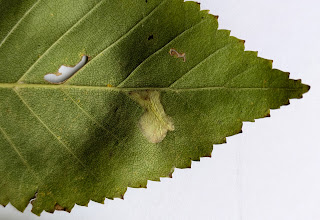After ploughing through both volumes of Micro-moth Field Tips, I am still struggling to identify these mines found this afternoon, so some help would be appreciated. (It feels a bit like when I started trying to identify micros!).
The first two examples are on birch, on the underside of the leaf, and both have active larvae in them, but I can only just see the head moving, so no detail.
The next two are on hazel and appear to be vacated--images of both upper and lower surfaces. Both have a mine in the body of the leaf, plus an edge folded over. My guess for these is Parornix devoniella.
The final mine is on beech, and here my guess is Stigmella tityrella
Thanks










Hello Phil,
ReplyDeleteThere's no need to apologise, everyone has to start somewhere! It is good that you are expanding into these early stages and giving us some good records along the way. Ben Smart's books are excellent but you should also be using the British Leafminers website (there's a link to it on the right-hand side-bar of this blog's home page). There you can choose "plants" across the top, find the particular host you are looking for and it lists out the various species you are likely to find. You can then click on each species name to find relevant images.
Your underside mines on birch (Betula) are both Phyllonorycter ulmifoliella. On hazel (Corylus) the earlier vacated mine - often triangular-shaped as here - and then final leaf-edge fold held down by silk do indeed indicate Parornix devoniella and there may well still be an active larva inside the fold. The mine and then leaf-edge fold aren't always on the same leaf and I think that's the case for your second hazel example, where the mine actually looks more like that of Phyllonorycter nicellii to me but the leaf-edge fold is good for Parornix devoniella. Finally, the mine on beech (Fagus) starting from the mid-rib is Stigmella tityrella as you say.
Thanks Dave, I'm encouraged that I got two correct! I have looked at the British Leafminers website before, but for some reason hadn't realised that I could search by host plant, so I'll definitely be doing that in future.
ReplyDelete